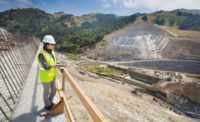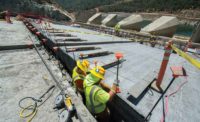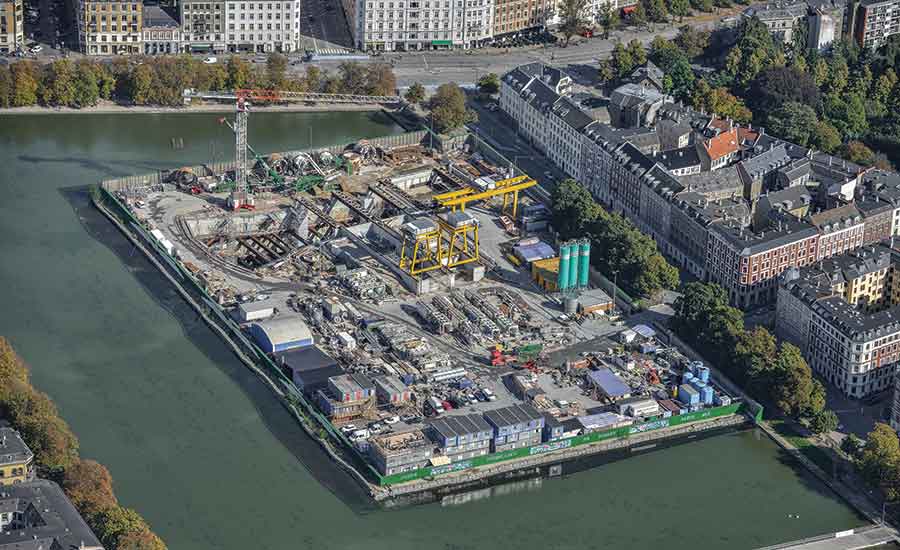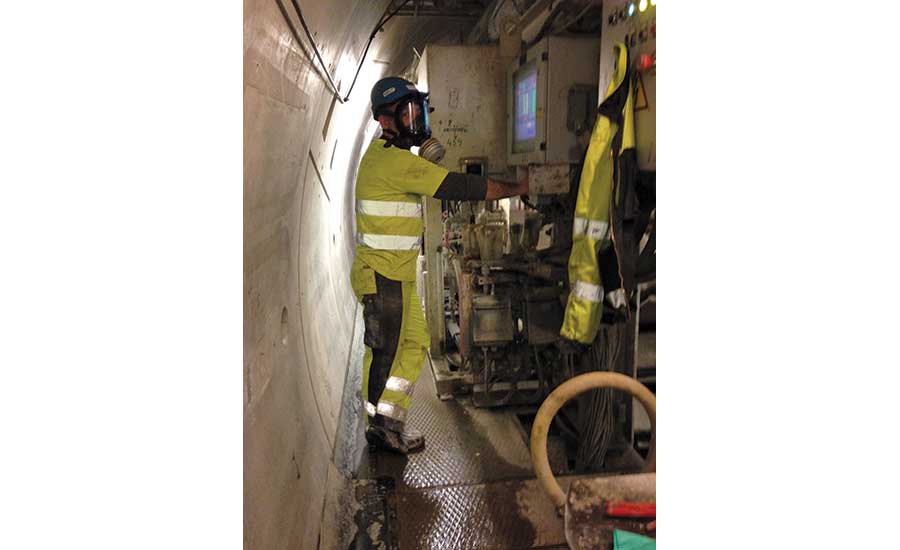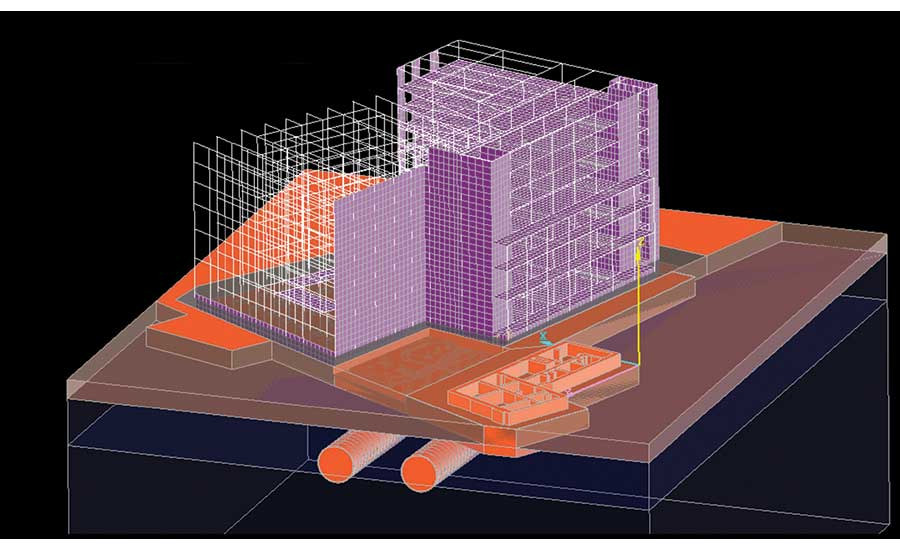Team Outwits Deadly Risks on Copenhagen Metro Expansion

At Øster Søgade, crews created a worksite within a centuries-old manmade lake to relaunch two of the TBMs, which continued their journey underneath Copenhagen’s urban core.
PHOTO COURTESY SELI TUNNELING DENMARK

To protect against deadly fumes and contaminants, designers modified the TBMs in several key ways. The screw conveyor discharge gate was sealed to prevent benzene evaporation. Water spillage was collected at the TBM invert for later treatment. Crews sprayed protective foam over muck cars to prevent contamination while material was transported out of the tunnel. Workers also donned gas masks in some instances.
SCHEMATIC COURTESY SELI TUNNELING DENMARK

To protect against deadly fumes and contaminants, designers modified the TBMs in several key ways. The screw conveyor discharge gate was sealed to prevent benzene evaporation. Water spillage was collected at the TBM invert for later treatment. Crews sprayed protective foam over muck cars to prevent contamination while material was transported out of the tunnel. Workers also donned gas masks in some instances.
PHOTO COURTESY SELI TUNNELING DENMARK

Skylights allow ample light into stations and open to vent smoke in case of a fire.
IMAGE COURTESY ARUP

Tunnelers had to contend with tight tolerances at Frederiksberg and other sites where the new metro line intersects an existing line.
IMAGE COURTESY SELI TUNNELING DENMARK

Architects provide plaza space at ground level.
IMAGE BY JESSICA SAVIDGE

Crews disassemble each TBM into about 20 pieces to be able to maneuver them up and out of the station.
IMAGE COURTESY JESSICA SAVIDGE

Once tunneling was completed, the Kobenhavn H station doubled as the extraction point for all four of the TBMs.
IMAGE BY JESSICA SAVIDGE

Along the 15.5-km loop (map, in red), tunnelers encountered numerous hazards.
MAP COURTESY OF CMT

To mitigate risk at Kongens Nytorv, where TBMs had little wiggle room to pass below Magasin du Nord, the team created a detailed 3D model of geotechnical conditions and the buildings’ structural elements.
MODEL COURTESY OF CMT

Inspectors used a mobile app to accept concrete lining segments or tag them for repair.

The TBMs installed a total of 135,000 curved concrete segments to form the circular tunnel lining. The team says it broke Danish records for most tunneling production in a week, at 176 m, and best month, building 734 m of tunnel.
PHOTO COURTESY SELI TUNNELING DENMARK

The TBMs installed a total of 135,000 curved concrete segments to form the circular tunnel lining. The team says it broke Danish records for most tunneling production in a week, at 176 m, and best month, building 734 m of tunnel.
PHOTO COURTESY SELI TUNNELING DENMARK













Contractors credit a balancing act between their preparedness to deal with anticipated hurdles and quick wits to tackle unexpected emergencies with helping them to wrap up tunneling operations earlier this year for Copenhagen’s third metro line. When confronted by potentially deadly environmental hazards, including benzene and carbon monoxide, designers retooled their tunnel-boring machines to protect workers and keep the project on track.
In addition, crews safely threaded the TBMs through extremely tight corridors beneath the foundations of historic buildings and above existing metro lines. Meanwhile, workers fanned out across the dense Scandinavian city to construct 17 subterranean stations, several crossovers and launch-and-retrieval structures, sometimes nestled right up against fragile old churches and other landmarks.
“It’s a huge logistical challenge to work on 22 different sites with 2,000 people working at the same time from several hundred different companies,” says Sigurd Nissen-Petersen, chief operating officer for Copenhagen Metro Team (CMT), the design-build consortium composed of Salini Impregilo (SI), Tecnimont and Seli SpA. After buying out most of the other firms’ shares and acquiring Seli subsidiary Seli Tunneling Denmark, which is the main tunneling subcontractor, SI currently holds more than 99% of the contract.
The $3.5-billion, eight-year effort started in 2011, building twin 15.5-kilometer-long metro tunnels in a ring underneath downtown Copenhagen. The line’s Danish name, Cityringen, translates to “city circle.”
Article Index:
Assembly Required
To excavate the tunnels, the first of two pairs of TBMs launched in 2013. However, before the second pair could launch, the project team had to overcome its first big hurdle when the TBM supplier went bankrupt.
“Because the original supplier was not capable financially to complete the construction on the machines, we built them here in Denmark ourselves,” says Valerio Violo, senior project manager with Seli Tunneling Denmark. After collecting all the parts from the supplier and having them shipped to a rented facility in Copenhagen’s harbor, Violo says that, at first, it was like receiving “an IKEA box without any instructions.”
Each TBM features a 5.84-meter-dia cutterhead to bore through areas of hard limestone and soft glacial deposits composed of till, gravel and clay. The TBM installs a ring of six 1.4-m-wide concrete segments, or stones, leaving a finished tunnel diameter of 4.9 m.
Eventually, the second pair of machines launched in mid-2014. Violo says the decision to build their own machines paid dividends later in the project when both pairs of TBMs had to be retrieved, disassembled, re-assembled at a new site and then relaunched due to the timeline of when certain stations and segments of tunnels had to be completed. Mechanics that had originally assembled the TBMs became the contractor’s long-term maintenance and modification crew.
The flexibility to self-perform modifications proved useful as the TBMs approached the southwestern corner of the city, a former industrial area with well-documented pollution, including chloroform, trichloroethylene, tetrachloroethylene, vinyl chloride and benzene. “The client [Metroselskabet] expected to find benzene in high concentration in the water and the soil, so we started in the very beginning of the project to carefully investigate” the scale of the contamination to mitigate the risk, says Riccardo Perlo, technical director and risk manager for CMT.
Around 2.7 km of tunneling was conducted through polluted ground in this area, with 300 m containing high concentrations of benzene. A volatile carcinogen that can cause major organ damage and even death, benzene easily evaporates to become airborne. Several TBM modifications were installed to combat this hazard. Designers sealed the screw conveyor discharge gate to prevent evaporation. Water spillage was collected at the TBM invert and stored in sealed tanks, from which it was pumped to the portal for treatment. The belt conveyor system that transports spoils was covered, and a robust air ventilation system exhausted the polluted air out of the TBM, where it was filtered.
The team also needed to cover the muck cars during transport out of the tunnel, but it was too risky for workers to physically place the covers. Therefore, engineers borrowed a method used at chemical plants to control spills. “We installed a spray system on the backup discharge point, which produced a thick and very stable foam that completely covered the muck, stopping or at least limiting evaporation,” Violo said in a presentation given at last year’s World Tunnel Congress in San Francisco.
According to Violo, it’s the first time this technique has been used in a tunneling operation, and other tunneling teams around the world facing similar hazards have since inquired about the strategy.
Of the 1.23 million cu m of earth removed during excavation, around 10% to 15% was contaminated and had to be disposed of at a special site. The rest was used for land reclamation within the city.
Unpleasant Surprises
While benzene and other industrial chemicals were anticipated, what crews experienced next was totally unexpected.
“Whenever you work in underground, you always have to plan for the worst,” Perlo says. “You have to implement a monitoring system that helps you with the early detection of possible problems.”
Thanks to this monitoring, while excavating on the north section of the circle through a 2-km stretch of soft ground, the TBM’s air-quality sensors suddenly alerted the team to the presence of carbon monoxide (CO), an odorless, colorless gas that substitutes for oxygen in the bloodstream and can quickly kill.
“Finding carbon monoxide underground is absolutely unheard of in the industry,” Violo says.
The gas peaked at 5,000 parts per million, which would be deadly in less than an hour’s exposure. Pressurizing the chamber, which is required any time workers need to enter the cutterhead to perform maintenance, would boost the concentration even higher. So, crews wore ventilators, and the air was cleaned.
Just two days after hitting CO, crews at another TBM, running slightly ahead, began complaining of an ammonia smell. “I said, ‘It’s not possible,’ ” Violo says. “Well, actually it was.” This danger again required crews to cover the belt and work with gas masks.
Then, several days later, during a hyperbaric intervention to allow workers to access the cutterhead, sensors detected hydrogen cyanide. “We immediately evacuated the tunnel,” he says. Since the substance is so uncommon in tunneling, “we had to Google what it was,” he notes. The extremely poisonous compound is best known as a chemical weapon used in World War II. Fortunately, it was at a low enough concentration to not be dangerous.
“We had a technical challenge, not a scientific one, so we just wanted to get rid of it and pass over it,” he says. “I’m still curious why those things were there, but it’s not my job to determine it.”
Tight Quarters
In several areas, including at the Frederiksberg and Kongens Nytorv stations where the new line intersects with an existing line built in the early 2000s, the TBMs had very little wiggle room.
At Kongens Nytorv, a congested square in the heart of the city’s shopping district, the TBMs needed to pass through a critical 70-m stretch of soft ground just 1.2 m above the existing metro tunnel. At the same time, it had to dive 3.7 m underneath several historic buildings housing pubs, a McDonald’s and a large shopping center, Magasin du Nord.
“The problem showed up at the beginning of the project because the available information we had showed us the possible presence of micropiles underneath the Magasin du Nord, but we didn’t know their length,” says Antonio Raschillà, technical director at Seli Tunneling Denmark.
After an extensive, multiyear risk assessment effort, which included a 3D model of the geotechnical conditions and structural elements of the key buildings, the team introduced a “very aggressive slope of 6%” to the tunnel route as it approached the station, rather than the typical 5%. It also underpinned the buildings using compensation and jet grouting to minimize settlement, Raschillà says.
Prior to TBM passage, thousands of sensors were placed all around to detect for displacement and track the TBM movement. The team set up a 24/7 war room, staffed with engineers and managers from all the key firms, and many others were on call and could monitor the readings via their smartphones. If settlement exceeded 2.5 millimeters during passage, it would trigger an additional compensation grouting plan.
“The food court was in the basement. So, just 3.7 meters above [our TBM], people were eating lunch.”
– Valerio Violo, Sr. Project Mgr., Seli Tunneling Denmark
The department store and other structures remained open during the passage. “The food court was in the basement. So, just 3.7 meters above [our TBM], people were eating lunch and dinner,” Violo says. “You could actually hear the TBM chugging underneath.”
After three years of preparation, the first TBM successfully made passage in mid-2016 in just three days, about twice as fast as expected, Raschillà says. One month later, the second TBM also made the delicate journey in only three days.
The maximum settlement was 0.8 mm, meaning no additional compensation grouting was needed.
Everyone was able to breathe a sigh of relief that the most difficult stretch was over, Violo says.
Ring Leader
The tunnel lining comprises 135,000 separate ring segments, manufactured by Mobilbaustoffe in Germany. On a typical day, the TBM would place between 60 and 70 of these “stones.” Tracking and performing quality control for that many segments through shipping, multiple distribution points and, eventually, to the jobsite using paper would have been a daunting process. Instead, the team developed a mobile app linked to a database in the cloud via Dropbox. Each segment bore a bar code, which was scanned at each step in the delivery and inspection chain. “Our target was complete traceability, from the production factory in Germany to one of the four TBMs and to the final position in the tunnels,” Violo says.
The app was used to mark and photograph damaged segments for repair. Final inspection was also carried out using the app, with results fed to the same cloud-based database. Any repairs were accepted through the app via electronic signature.
The streamlined, paperless process allowed Seli Tunneling to turn over segments of the tunnel to the electro-mechanical subcontractor more efficiently and quickly, Violo says.
Changing Stations
Cityringen station architect Nille Juul-Sorensen says the stations were designed to provide a sense of security and be easily navigable, “so you don’t need to read a book to find your platform.” Now the director and global business leader, architecture, at Arup, he previously designed the stations for the previous two metro lines when at another firm.
Stations range in depth from 10 m to as much as 40 m. Most follow a rectangular configuration, approximately 80 m long by 20 m wide. A station built next to Marmokirken (also known as Frederik’s Church) sits the deepest because of an extremely narrow site. The station’s walls are just 1.5 m from the church, and it is one of the few sites where the two tunnels and platforms stack atop one another, rather than sitting side by side with a central platform.
Crews excavate the stations prior to the arrival of the TBMs. The city’s water table hovers around ground level, so crews start by installing a watertight underground “box” via secant piles or hydromilled slurry walls, able to withstand water pressure of up to four bars, Perlo says. At most stations, crews then excavate to depth and install the bottom slab. But at Marmokirken, to mitigate against settlement in the church, workers built the top slab first, to form a very stiff box. Several openings in the top slab allowed crews to remove the excavated dirt from below. As a result, “we’ve recorded almost zero settlement in the church,” he says.
Due to the sequencing of station construction with tunneling, some stations have remained active jobsites for several years. “To ensure that neighbors can access their buildings, we had to change the shape of the sites many times according to the construction phases,” says Fabio Visintin, area construction manager with Salini Impregilo. For example, at Kongens Nytorv, which is surrounded by major thoroughfares, “the site has been assembled and dismantled many times in order to comply with the traffic regulations,” he adds.
When Cityringen opens in mid-2019, trains supplied by rail contractor Ansaldo STS will run every 90 seconds and take just 24 minutes to circumnavigate the 15.5-km loop around the city.


